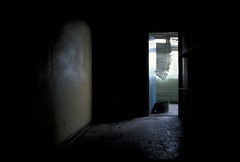Tuesday, February 06, 2007
dub, decay and delay
Australian duo Moving Ninja first came to dubstep prominence on DJ Pinch’s Bristol based Tectonic label and while their first release under-whelmed, their new EP is shocking in its breathtaking restraint.
When the first roots of dubstep were being put to ground, what made them sound so fresh were the prevailing drum & bass winds. At that time, around 2000, Bad Company were beginning to dominate turning jungle into an over-dark, over-hard mess. But by contrast, innovators like El-B’s Ghost camp’s sound purveyed a restrained ‘edgy’ twist on the sexy 2step sound rather than engaging in an out and out, pumped up, darker-than-dark, masculinity contest.
The same comparison holds true today, early in 2007. Some parts of dubstep now tries to be darker and harder than its rivals, and its vision is increasingly restrictive at best, boring at worst. Much of the spacious, textural ‘edgy’ sounds are being drowned out, with the prominent exception of Burial.
The Hyperdub recording artist is perhaps then a useful reference point for the new Moving Ninja EP (hear clips here), though it was recorded long before the Burial hype peaked. Of the four tracks, “Uranium” and “Kemancheh” are the pinnacle, the kind of intricate excursions that would surely be forsaken if all dubstep were exclusively dancefloor orientated.
“Uranium” has a remarkable beginning. Jabba from Moving Ninja explains: “it started out as a sound installation I did for uni made up of field recordings from an abandoned mental hospital in Sydney. I’m really fascinated by those kinds of places and there is so much photography based around that aesthetic that I really wanted to record some sounds in there. The result ended up being a collection of samples that I’d never heard anywhere else. Sounds of beds being thrown down stairs and bathtubs dragged across broken tiles, all surrounded by the crunching of leaves and dirt that had gathered over time. I guess after that those sounds and the feelings of being in that place were the inspiration for the rest of the track.”
The track presents the listener with a dense field of processed sound, dark textures leaving space for the imagination to wander. Coupled with the knowledge of their origin, the track explodes with malevolent possibility and potential.
Dubstep has had a longstanding relationship with its environment, its use of reverb to create space and dark textures is perfectly suited to night time greater London. Its use of delay perfectly suited to reflect urban decay. “Uranium” leaves the mind boggling over the ghosts of tortured lives past. Seldom has a track so effectively encapsulated this spatial/ musical relationship, as “Uranium.”
Jabba highlights Opacity while personally Left London and Derelict London, while both different in approach are mesmerising. Flickr as always provides interesting viewing. What makes abandoned and decaying locations such compelling environments? While I have no experience of Sydney, London is littered with abandoned buildings, relics of past lives, not still merely changing at a much slower rate to the rest of its often frantic surroundings. Despite property prices continuing to soar to some of the highest levels in the globe, abandoned buildings surprisingly appear throughout the city, not just in the less affluent, marginal areas like Hackney but in central, zone 1 locations like Kings Cross and even Soho and Bloomsbury. Through musty boarding, glimpses of old interiors can often be seen, full of rotting floorboards and fragmented rubble.
Decaying buildings are mesmerising because they seem to remind us of our own mortality. Even a thriving city built of seemingly indestructible concrete, glass and steel can break down. Even the unwavering, regimented straight lines of roads and walls will at some point return to jagged rubble and twisted metal. Like Shackleton said on “Blood on My Hands,” “...flesh is weak and forms break down. They cannot last forever.” And while that might seem a pessimistic outlook, two thoughts suggest the opposite.
Firstly the fact that in each of these spaces, although there is destruction, there is also - as weeds grow through the inorganic rubble - new life, as nature reclaims a small part of the urban landscape. Secondly there is comfort in aligning yourself with the reality of this process, instead of living with the escaspism or delusion that everything lasts forever. It’s for this reason that the cleanest, most pristine parts of a city often feel the most fake or unreal, and the grittiest bits, while harsh, can be the most rewarding.
Moving Ninja have several projects in the pipeline. They’re getting their Aquatic Lab label off the ground with Paul from Garage Pressure. An album might see the light of day on Tectonic/Subtext, depending how the tracks turns out. And Jabba is writing a lot of other material for a solo project called Deadleaf (hear an example “Save From the Flames Whatever Yet Remains”). As fits his music, Jabba’s also writing the script and the score for a feature film with a friend.
Subscribe to:
Post Comments (Atom)




2 comments:
I listened to Uranium at Boomkat, ten seconds in my jaw wouldn't stay shut.
Good stuff, I might not have picked it up after buying their first one.
I was so amazed by moving ninja's tracks, that used to be available in full length mp3s on their site, I used them as the sound track to one of my short videos that I did last spring for my video production class at Emerson College here in Boston.
http://vizzie.com/movies/3days_final.mov
moving ninja's sounds really made the video seem much better, but nothing could fix the confounded ending... never could figure out a good ending.
Post a Comment